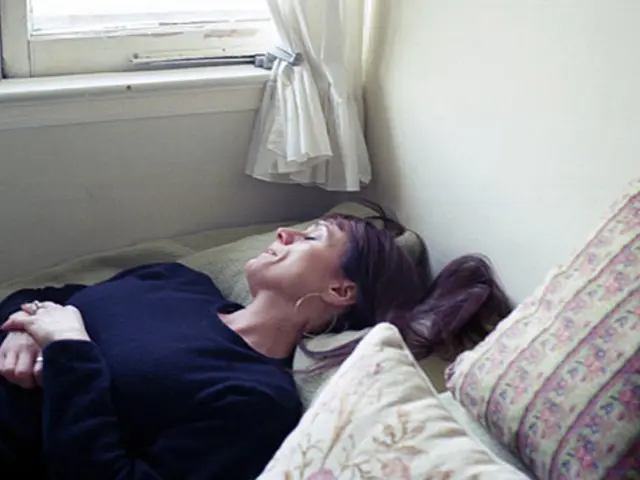Right Side Headache Origin, Implications, and Swift Alleviation Strategies
Unleashing the Mystery of One-Sided Headaches: Focusing on the Right Side
Ever wondered why some people experience headaches only on one side, particularly the right side? Delve into the fascinating world of headaches and find out the possible culprits behind your pain.
Headaches, a universal ailment, are known for their varying durations, frequencies, and locations. Let's explore the potential reasons for headaches on the right side of the head and the potential solutions to ease the pain.
What triggers a headache on the right side?
While some conditions cause headaches on both sides, others can lead to localized pain. Let's take a closer look at the conditions that mostly affect a single side, with the right side being our focus.
Single-Sided Conditions
A headache localized on the right side might be caused by the following:
- Temporal Arteritis: This condition involves inflammation of the temporal artery, usually on just one side. Symptoms include fatigue, jaw pain, and tender temples.
- Trigeminal Neuralgia: Characterized by intense facial and head pain, this condition typically affects one side at a time due to a disruption to the trigeminal nerve at the base of the brain.
- Sinus Headaches: Individuals with a deviated septum are more prone to sinus headaches that can localize on the affected side.
Bilateral Conditions
Conditions like Occipital Neuralgia usually affect both sides, but can cause one-sided symptoms. However, the distinctive feature of this condition is sharp pain in the back of the head and neck and sensitivity to light.
Other causes of headaches can lead to pain across the entire head or just one side. These include allergies, aneurysms, fatigue, head injuries, sinus infections, fluctuations in blood sugar levels, dehydration, muscle strains or knots in the neck, tumors, and medication use.
Why does medication use lead to headaches on the right side?
Headaches can be a side effect of both prescription and over-the-counter medications. Overuse of medication, including OTC painkillers like acetaminophen (Tylenol), aspirin, and ibuprofen (Motrin, Advil), can cause what is known as a medication overuse headache. This common type of headache can affect either side or only one, and it does not always affect the same location.
Which types of headaches target the right side?
There are numerous types of headaches, some of which affect one side more than the other. The following headaches are likely causes of a right-sided headache:
- Migraines
- Cluster headaches
- Tension headaches
Migraines
Migraines have a genetic component and produce severe symptoms, such as a pulsating sensation or throbbing pain in the head. Genetics might dictate whether a migraine occurs on the right or left side, but it is not always the case.
The severe pulsating sensations or throbbing are accompanied by blurred vision, nausea, sensitivity to light, and sensitivity to sound.
Cluster Headaches
Cluster headaches are severe headaches that occur in recurring patterns. The pain is intense and usually localized around one eye but can radiate to other areas of the head and face, including the right side.
These headaches usually occur frequently for weeks or months before a period of remission. Other symptoms include facial sweating, pale or flushed skin, red or watery eyes, restlessness, stuffy or runny nose, swelling around the affected eye, and neck pain.
Tension Headaches
Tension headaches are the most common, affecting around 1 in 5 people. While they usually affect both sides of the head, some people may have symptoms on one side only.
Signs include dull, aching pain, scalp tenderness, tender or tight shoulder and neck muscles, tightness or pressure across the forehead, sides, or back of the head.
When to consult a medical practitioner
While most headaches resolve on their own, those experiencing frequent headaches should consult a healthcare professional to identify the underlying cause. Anyone experiencing the following symptoms alongside a headache must seek immediate medical attention:
- Vision changes
- Confusion
- Fever
- Head injury
- Increased pain during movement
- Neck stiffness
- Numbness
- Personality or cognitive changes
- Rash
- Sleep disturbances
- Slurred speech
- Weakness
Frequently Asked Questions
Identifying the location of a headache can help medical professionals diagnose the specific headache and plan appropriate treatment.
For example, headache pain at the front or on one side of the head might indicate migraine or cluster headaches.
Some headaches may subside without intervention, while others may require at-home treatments like OTC pain relief medications, a nap, or changes in lifestyle.
However, if headaches are severe, frequent, progressive, or accompany other symptoms like vision changes or slurred speech, it is essential to consult a healthcare provider.
Dehydration can cause or exacerbate headache symptoms and headache disorders. Adequate hydration is the best preventive measure against dehydration headaches.
To treat this type of headache, healthcare providers typically address the dehydration, usually by replenishing lost fluids.
Migraines can target either side of the head. While an individual's migraines may consistently affect one side, this is not always the case. Other causes include neurological issues, tension headaches, medication side effects, and allergies.
One-sided headaches are a common complaint, and while not always migraine-related, it is crucial to consult a healthcare professional if they are frequent, severe, or worsening to determine the precise cause and appropriate treatment.
- A person might experience a one-sided headache due to conditions like Temporal Arteritis, Trigeminal Neuralgia, or Sinus Headaches that predominantly affect one side, particularly the right side.
- In some cases, the right side of a person's head may be affected by Occipital Neuralgia, which usually causes pain on both sides, but symptoms can be one-sided.
- Medication use, including over-the-counter painkillers, can lead to a medication overuse headache, which may target either side or just one, usually the right side.
- Migraines, cluster headaches, and tension headaches are types of headaches that often affect the right side of a person's head.
- Migraines can produce severe symptoms such as pulsating sensations and nausea, and the side affected may be genetic.
- Cluster headaches are intense headaches that usually occur around one eye and can radiate to other areas, including the right side of the head.
- Tension headaches are the most common and can affect one side, often the right side, with symptoms including dull, aching pain and scalp tenderness.
- Frequent headaches should be evaluated by a medical professional to identify the underlying cause and rule out potential medical conditions like Vision changes, Numbness, Personality or cognitive changes, and Slurred speech.
- In addition to headaches, a person's health and wellness can be improved through workplace-wellness programs, mental-health support, fitness-and-exercise routines, skin-care practices, and proper nutrition.
- CBD, a compound found in cannabis, has shown potential benefits for the treatment of neurological-disorders and migraines, providing relief for certain health-and-wellness concerns.






